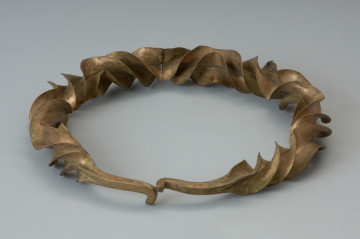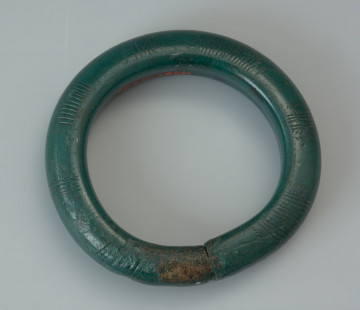
A bracelet with stamped ends
around 900 p.n.e. — 750 p.n.e.
National Museum in Szczecin
Part of the collection: Bronze Age
The beautiful bracelet is made of a thick gold plate. It is crowned with the so-called stamped ends, ornamented with impressive all-around ribbing. On the other hand, the bow is decorated with groups of transverse incisions and a zigzag motif. In archaeological literature, this type of bracelet is referred to as Goldene Eidringe, which translates as "oath rings". Danish researcher Christian Jürgensen Thomsen introduced this romantic name into the scientific literature in 1837. The bracelet belongs to a hoard discovered during ploughing, probably around the middle of the 19th century. The entire deposit consisted of three gold bracelets of one type hidden in a clay pot. It was bought for the collection of the Society of History and Antiquities of Pomerania (Towarzystwo Historii i Starożytności Pomorza) in Szczecin from Dreher, the owner of the estate in Orle. At the end of the Second World War, the hoard was evacuated to western Germany and hidden from destruction or robbery. The bracelets returned to Szczecin in 2009 as part of the Polish-German exchange of old archaeological collections. Originating from the Nordic culture, the bracelets with stamped ends, characteristic of the Late Bronze Age, probably arrived in Pomerania as part of a trade with northern European communities. The analysis of technical details allows the assumption that these bracelets were not manufactured in local Pomeranian workshops.
Dorota Kozłowska
Other names
Eidringe; oath rings
Author / creator
Dimensions
the entire object: height: 1 cm, width: 7 cm
Object type
bracelet, body adornment
Technique
carving, bending, tapping, casting
Material
gold
Origin / acquisition method
legal transfer
Creation time / dating
Creation / finding place
Owner
National Museum in Szczecin
Identification number
Location / status

around 900 p.n.e. — 750 p.n.e.
National Museum in Szczecin

around 600 p.n.e. — 400 p.n.e.
National Museum in Szczecin

around 1100 p.n.e. — 1000 p.n.e.
National Museum in Szczecin
DISCOVER this TOPIC
National Museum in Szczecin
DISCOVER this PATH
Educational path